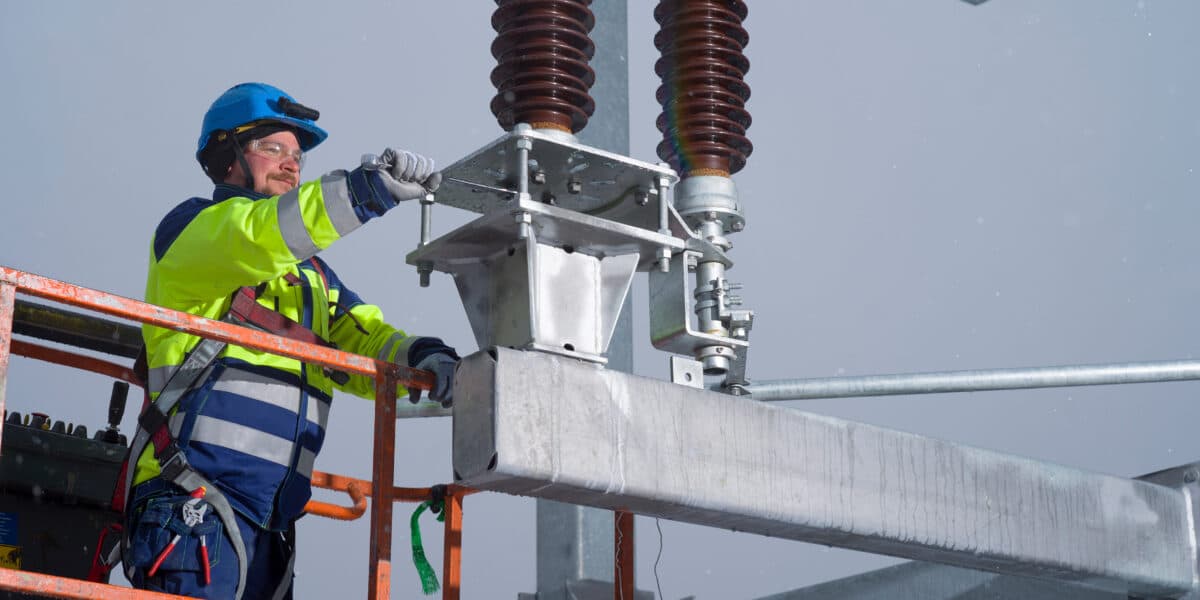There is reason to be cheerful on the site of the new Valkeus substation, as the personnel working there met all of Fingrid’s preventive safety targets last year.
“There were plenty of risk assessments, safety observations, safety toolbox talks, and safety discussions, and we did not have any sick leave due to accidents,” says Aleksi Mäkilä, Worksite Manager from Caverion Industria.
Operating methods have been developed with safety in mind. For example, QR codes are used on the Valkeus worksite to make it easier to submit safety observations.
“The QR code has helped us to submit far more safety observations than before.”
“The code links to a form, prefilled with all the worksite details, so employees can start recording their observations right away. The QR code has helped us to submit far more safety observations than before because it is so easy now, and there is no need for employees to spend their coffee breaks dealing with paperwork,” Mäkilä says.
Safety observations lead to improvements
Fingrid’s primary objective is to have zero accidents on its worksites. The milestone is a lost-time injury frequency of less than five.
“Ideally, a safety mindset and preventive approach would become second nature on worksites. For example, submitting safety observations would be an integral part of on-site work rather than an extra step for employees to think about,” says Timo Kiiveri, Senior Vice President at Fingrid.
Safety observations can be quite mundane, such as the need for warmer work gloves or a new blade guard for a grinder.
One of the responsibilities of a supervisor is to read through every safety observation and address any problems. It is frustrating if an employee reports something that undermines safety but nobody takes action.
“Employees are more likely to continue submitting safety observations if they lead to tangible improvements, such as making a better access route or buying brighter lights around the site hut,” says Aleksi Mäkilä.
Installation technicians involved in writing instructions
Enersense is a contractor on Fingrid’s worksites in Leväsuo, Isojoki and Simojoki, among others. Last year, Enersense began updating its work instructions. This involved reviewing all the instructions and associated safety aspects with the installation technicians and supervisors.
“Work instructions should provide as much detail as possible about how to do the work correctly and safely. Installation technicians have the most valuable experience in this area. Our subcontractors were also involved in revising the work instructions,” says Paavo Kaija, Project Manager at Enersense.
Safety is also covered at worksite start-up meetings. Invitations are also sent to as many installation technicians and subcontractors’ supervisors as possible, so important information goes directly to the people who do the work.
Furthermore, personalised orientation is provided before any work begins, so newcomers learn and internalise all the safety issues.
“We always customise our orientation programmes based on each person´s background.”
“We have lots of people with widely differing experience levels on our worksites, so we always customise our orientation programmes based on each person’s background,” Kaija emphasises.
Caverion Industria, on the other hand, has introduced a top-down approach to orientation. This means that supervisors communicate safety practices to their subordinates, who then hand them down to their own subordinates.
“This enables everyone to take the safety issues
on board more thoroughly,” Mäkilä explains.
Attitudes improving further among installation technicians
Enersense usually uses subcontractors in its large projects, but the project managers and people responsible for safety are mostly Enersense employees.
“We have well-established subcontracting chains, making it easier to look after safety. We are a team of familiar faces, even though some of us wear a different company’s colours. We all take responsibility for safety,” Kaija says.
He praises the safety attitude of employees and emphasis that those who have been in the industry for a long time also take safety into account in their everyday work. The number of occupational accidents is decreasing all the time, and we hardly have any injuries resulting in sick leave.
“We have veterans who have been working here since the 1980s. We also have newer people starting out in their careers, and everyone in between. Our people are very receptive to safety matters, irrespective of their experience levels.”







